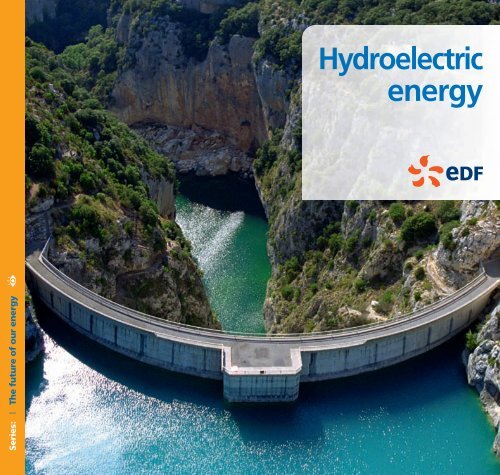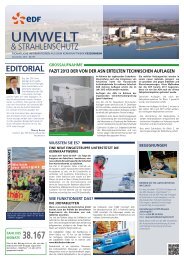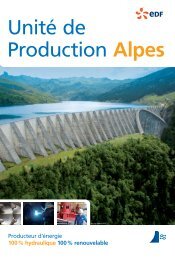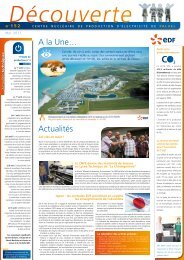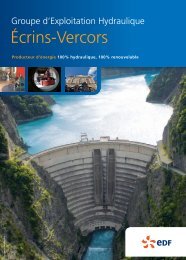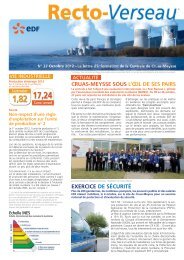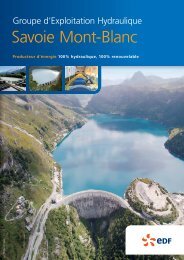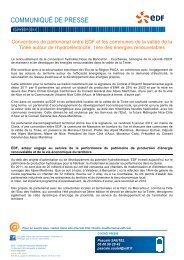Hydroelectric energy - Energie EDF
Hydroelectric energy - Energie EDF
Hydroelectric energy - Energie EDF
Create successful ePaper yourself
Turn your PDF publications into a flip-book with our unique Google optimized e-Paper software.
Series: | The future of our <strong>energy</strong><br />
<strong>Hydroelectric</strong><br />
<strong>energy</strong>
“How to reconcile power<br />
generation with environmental<br />
protection?“<br />
“Is <strong>EDF</strong><br />
competitive?“<br />
“25% of the world’s<br />
population uses almost<br />
two thirds of the world’s<br />
<strong>energy</strong> resources.“<br />
PERFORMANCE<br />
SAFETY<br />
ENERGY EXPERTISE<br />
A key player in the landscape of <strong>energy</strong><br />
challenges, <strong>EDF</strong> generates ample quantities<br />
of <strong>energy</strong> in varied and environmentallyfriendly<br />
forms, thus providing the wider<br />
public with access to electricity.<br />
“Energy demand could<br />
increase by 60% by the<br />
year 2030.“
<strong>EDF</strong>,<br />
EUROPEAN<br />
LEADER IN POWER<br />
GENERATION<br />
The <strong>EDF</strong> group has a stake in the main<br />
leading European <strong>energy</strong> markets:<br />
the United Kingdom with <strong>EDF</strong> Energy,<br />
Italy with Edison, and France where <strong>EDF</strong><br />
is leader in its market. With its mix of<br />
nuclear, hydroelectric, fossil-fi red and<br />
other renewable energies, <strong>EDF</strong> operates<br />
a highly effi cient, diversifi ed and<br />
comprehensive power generation fl eet.<br />
POWER GENERATED BY <strong>EDF</strong><br />
IN MAINLAND FRANCE, 2010*<br />
407.9 TWh<br />
86.7%<br />
Nuclear<br />
45.4 TWh<br />
9.7%<br />
<strong>Hydroelectric</strong>**<br />
16.9 TWh<br />
3.6%<br />
Fossil-fi red<br />
* These fi gures are rounded off to one decimal point as compared with<br />
exact values.<br />
** Including power generated by pumped-storage plants.<br />
INSTALLED CAPACITY<br />
in France as at 31 December 2010.<br />
NATIONAL POWER OUTPUT*<br />
were generated by <strong>EDF</strong> in France in 2010.<br />
of the electricity generated<br />
by <strong>EDF</strong> does not emit greenhouse<br />
gases.<br />
FRENCH FLEET<br />
19 nuclear<br />
power plants<br />
439<br />
hydroelectric<br />
plants<br />
UNITS OF MEASUREMENT<br />
• Mechanical and electrical power is measured<br />
in Watts (W).<br />
• The megawatt/hour (MWh) is the amount of<br />
power generated by a 1-megawatt (MW) generation<br />
facility within a one-hour period.<br />
• 1 MW = 1 000 kilowatts (kW) = 1 million watts.<br />
• 1 terawatt/hour (TWh) is equal to<br />
1 billion kWh.<br />
23 fossil-fi red<br />
plants<br />
and<br />
13 gas<br />
turbines
Turbine building<br />
at the Pragnères<br />
power plant.
Cover:<br />
Sainte-Croix-de-Verdon<br />
dam (Alpes-de-Haute-<br />
Provence).<br />
04<br />
Water: the<br />
world’s main<br />
form of<br />
renewable<br />
<strong>energy</strong><br />
A clean and<br />
fl exible form of<br />
<strong>energy</strong>, water<br />
ranks fi rst among<br />
the world’s<br />
renewable<br />
energies.<br />
06<br />
The incredible<br />
fl exibility of<br />
water<br />
Hydro power: an<br />
essential<br />
component of<br />
France’s <strong>energy</strong><br />
landscape.<br />
08<br />
From water to<br />
electricity:<br />
how does<br />
it work<br />
How a hydraulic<br />
plant works.<br />
10<br />
Hydro power:<br />
<strong>energy</strong> of the<br />
future<br />
Hydro power and<br />
tomorrow’s<br />
economic and<br />
environmental<br />
challenges<br />
Creation of series: Spécifi que<br />
Production and design:<br />
Translation: Concept & Langage – Photo credits:<br />
Onoky/Photononstop, Getty Images/DR,<br />
<strong>EDF</strong> media library/Laurent Baratier, Gilles de Fayet,<br />
Claude Pauquet, Thierry Renavand<br />
Printers: JPA - REF.ENE965-2011<br />
Printed on 50% recycled, 50% FSC paper.<br />
Hydro power:<br />
the <strong>energy</strong> of choice<br />
By 2020, 20% of European electricity demand will<br />
have to be met by resorting to renewable energies,<br />
if greenhouse gas emissions are to be reduced.<br />
In France, 10% of the electricity generated by <strong>EDF</strong> is<br />
already being sourced from hydro power facilities.<br />
The world’s main renewable <strong>energy</strong> form,<br />
hydroelectric <strong>energy</strong> is a sustainable, fl exible and<br />
competitive source of electricity. As it does not emit<br />
carbon dioxide, it is also of great benefi t<br />
to the environment. Furthermore, it provides an<br />
inexpensive solution to sudden fl uctuations in<br />
electricity demand. Being a public commodity, it is<br />
essential that suffi cient supplies of water be made<br />
available to cater for all needs: electricity, drinking<br />
water, farming, industry and tourism. It goes<br />
without saying that every effort is made to<br />
guarantee absolute safety.<br />
www.edf.com
<strong>Hydroelectric</strong> <strong>energy</strong><br />
WATER: THE WORLD’S<br />
MAIN FORM OF<br />
RENEWABLE ENERGY<br />
Hydro power is an essential source of electrical <strong>energy</strong>, standing head to<br />
head with nuclear <strong>energy</strong> on a global scale. It ranks first among all renewable<br />
<strong>energy</strong> forms.<br />
This environmentally-sound <strong>energy</strong> form does not contribute to the increase in<br />
greenhouse gases or to air pollution, as it does not emit carbon dioxide or any<br />
polluting gases.<br />
<strong>Hydroelectric</strong> power has its own place within the natural water cycle (rainfall,<br />
snow melt, mountain streams and rivers): water is kept in dams and used to<br />
drive turbines and generate electrical current.<br />
It is not so much the water head as the amount of available water contained<br />
in the dam that determines a hydro plant’s capacity. Indeed, the world’s four<br />
leading hydropower producers are flat countries with large catchment areas:<br />
United States, Russia, Canada and Brazil.<br />
France’s natural landscape provides the ideal conditions for hydroelectric<br />
power generation: regular rainfall, contrasting terrain, long waterways and<br />
a dense hydrographical network.<br />
04<br />
GREENHOUSE<br />
EFFECT<br />
This natural<br />
phenomenon leads<br />
to the warming of<br />
the atmosphere and<br />
surface of a planet<br />
that is exposed to<br />
solar rays.
Renewable energies<br />
These are very long-term, inexhaustible<br />
sources of primary <strong>energy</strong>, as they are<br />
directly or indirectly derived from solar<br />
<strong>energy</strong>, the earth’s <strong>energy</strong> or gravity.<br />
Renewable energies include solar<br />
<strong>energy</strong>, wind <strong>energy</strong>, hydro <strong>energy</strong><br />
(dams), the biomass (organic matter that<br />
releases <strong>energy</strong>, such as burning wood),<br />
geothermal <strong>energy</strong> that uses heat from<br />
the depths of the earth, and tidal<br />
<strong>energy</strong>. These <strong>energy</strong> forms do not<br />
become depleted and most of them are<br />
non-polluting.<br />
GLOBAL ELECTRICAL POWER OUTPUT IN 2009<br />
Source: Observ’ER 2010<br />
67.2%<br />
Fossil fuels (coal,<br />
petroleum, gas)<br />
16.1%<br />
Hydro<br />
13.5%<br />
Nuclear<br />
3.2%<br />
Others renewable<br />
energies<br />
hydro power producer<br />
<strong>EDF</strong> is the European Union’s leading hydro<br />
power producer, with more than 20,000 MW of<br />
installed capacity spread across nearly 450 hydro<br />
power sites, ranging from about 10 kW to<br />
several hundreds of MW. 70% of France’s<br />
hydroelectric <strong>energy</strong> potential, estimated at<br />
98 TWh/year, is currently being used. Hydro<br />
<strong>energy</strong> plays an instrumental role in France’s<br />
<strong>energy</strong> independence, saving the country as<br />
many as 13 million tons of oil every year.<br />
DID YOU KNOW?<br />
CLEAN AND ECONOMICAL<br />
While hydro power is dependent upon the<br />
vagaries of climate, it is nevertheless the only<br />
fi nancially viable source of renewable <strong>energy</strong>.<br />
7.5 BILLION CUBIC METRES<br />
The total volume of water stored in all <strong>EDF</strong> dams.<br />
05
<strong>Hydroelectric</strong> <strong>energy</strong><br />
THE INCREDIBLE<br />
FLEXIBILITY OF WATER<br />
Adjusting load on the French power grid<br />
With water reserves amounting to 7.5 billion cubic meters, and 20 GW of installed<br />
capacity, dams and hydroelectric plants are able to constantly adjust the quantity<br />
of power generated to the variations in demand for electrical current (in very<br />
cold weather or during peak periods, or as a result of incidents occurring on the<br />
grid or at other plants), thereby adding to the power generated by nuclear and<br />
fossil-fi red facilities. The hundred leading hydro plants are controlled by four<br />
hydroelectric control centres located in Lyon, Toulouse, Sainte-Tulle and Kembs.<br />
Energy on tap<br />
While <strong>energy</strong> cannot be stored on a large scale, water can nevertheless be<br />
captured in large reservoirs by using dam walls or dikes to store potential <strong>energy</strong>.<br />
The release of this water unleashes this <strong>energy</strong>, the magnitude of which increases<br />
or decreases in proportion to water head and fl ow rate. The channelled water<br />
drives turbines which generate electricity immediately. A hydroelectric plant can<br />
reach its maximum capacity within a few minutes, as opposed to about 10 hours<br />
for a conventional fossil-fi red plant and about forty hours for a nuclear reactor.<br />
Its fl exibility and country-wide water reserves make hydro <strong>energy</strong> the ideal means<br />
for adjusting electrical power during periods of peak demand.<br />
06<br />
20 GW OF<br />
INSTALLED<br />
CAPACITY<br />
45 billion kWh<br />
generated each<br />
year.<br />
439 plants ranging<br />
from less than a<br />
hundred kW to<br />
1,800 MW.<br />
640 dams, 150 with<br />
a head of more<br />
than 20 metres.
Operating around the clock and 365 days a year,<br />
the operating centres cater to the needs of the<br />
national grid and remotely control the country’s<br />
hydro generation facilities, promptly responding to<br />
peaks in demand.<br />
SPREAD OF INSTALLED CAPACITY<br />
IN MAINLAND FRANCE (<strong>EDF</strong> FLEET).<br />
Central France<br />
South-Western<br />
France<br />
Eastern<br />
France<br />
Alps<br />
Mediterranean<br />
1,800 MW within the space<br />
of 2 minutes<br />
Commissioned in 1985, the<br />
Grand’Maison power plant in the<br />
Isère, region of France, is the<br />
most powerful hydroelectric facility<br />
in France. Within the space of<br />
two minutes, it is able to generate<br />
1,800 MW of electrical power,<br />
tantamount to the power generated<br />
by two nuclear reactors.<br />
Grand’Maison is a pumped-storage<br />
facility that uses two reservoirs at<br />
two different heights. During periods<br />
of high demand, the water in the<br />
upper reservoir is pumped down to<br />
the lower reservoir. When the<br />
demand for electrical power drops,<br />
the water is pumped back to the<br />
upper reservoir.<br />
07
<strong>Hydroelectric</strong> <strong>energy</strong><br />
FROM WATER<br />
TO ELECTRICITY:<br />
HOW DOES IT WORK<br />
From source to power plant<br />
From time immemorial, the force of water has always fascinated man,<br />
while its secrets have been known since ancient times: harnessing of<br />
water, aqueducts, water head, wheels and mills. Mediaeval industry grew<br />
through the harnessing of this driving force. The invention of the turbine,<br />
followed by that of the generator in the 19 th century made it possible to<br />
generate electricity from hydro <strong>energy</strong>.<br />
A precursor in the use of energies harnessed from the sea, <strong>EDF</strong> has been<br />
operating the tidal plant at la Rance (Ille-et-Vilaine) for more than<br />
40 years. In July 2008, <strong>EDF</strong> decided to build a pilot marine turbine farm at<br />
Paimpol-Bréhat (Côtes-d’Armor) in order to harness <strong>energy</strong> from sea<br />
currents to generate electricity.<br />
08
How<br />
a hydro plant<br />
works<br />
The principle is simple and relies on the force of gravity:<br />
potential <strong>energy</strong> from water contained in dams is<br />
converted into mechanical <strong>energy</strong> by means of a turbine,<br />
which is in turn converted into electrical <strong>energy</strong> using a<br />
generator.<br />
The dam is used to store up large quantities of water by<br />
forming a lake (1). When the sluice gates are opened, the<br />
water fl ows into a penstock or channel (2) which directs it<br />
towards the power plant. The water causes the turbine to<br />
rotate (3). The turbine drives the generator (4), which<br />
generates electrical current. This current is rectifi ed by a<br />
transformer (5) before being transmitted along highvoltage<br />
power lines. Outside the power plant, the water<br />
returns to the river via the tail-race (6).<br />
HOW A HYDRO PLANT WORKS<br />
Storage reservoir<br />
1<br />
Tunnel<br />
Dam<br />
2<br />
Penstock<br />
3<br />
Turbine<br />
4<br />
Generator<br />
5<br />
Transformer<br />
6<br />
Different plants for different<br />
landscapes<br />
Hydro plants come in a<br />
variety of forms, depending<br />
on the layout of the<br />
waterway, the terrain or the<br />
water head:<br />
– Mountain sites with a steep<br />
gradient, such as the Portillon<br />
plant in the Pyrenees (1,420 m<br />
head in a penstock), but with<br />
a low fl ow rate;<br />
– Medium-head plants with a<br />
higher fl ow rate;<br />
– Run-of-river plants, with a<br />
slight gradient (10-15 m) but a<br />
very high fl ow rate, as found<br />
in large rivers (Rhine, Rhône,<br />
Isère, Durance, etc.);<br />
– Pumped-storage plants,<br />
pumping water downhill<br />
during peak periods and<br />
pumping water uphill during<br />
quiet periods;<br />
–Tidal plants, such as la Rance<br />
in Ille-et-Vilaine, driven by the<br />
tides.<br />
Depending on the type of<br />
dam (arch dam, weight,<br />
abutments, rock fi ll or earth<br />
dam, moveable dam, high,<br />
medium or low-head dam),<br />
three types of turbine are<br />
essentially used: Pelton,<br />
Francis and Kaplan<br />
respectively.<br />
DID YOU KNOW?<br />
AVAILABLE CAPACITY<br />
Available capacity (kW) is a<br />
combination of two factors:<br />
water head (m) and derived<br />
fl o w ( m 3 /s).<br />
09
<strong>Hydroelectric</strong> <strong>energy</strong><br />
HYDRO POWER:<br />
ENERGY<br />
OF THE FUTURE<br />
Given the challenges arising over the forthcoming decades in the form of a<br />
two-fold increase in global <strong>energy</strong> demand, compounded by the greenhouse<br />
effect, renewable energies, including hydro power, will be occupying centre stage.<br />
At the outset of this 21 st century, one person in two does not have access to<br />
electricity. At the same time, the growth of developing countries has given rise to<br />
huge <strong>energy</strong> demand. It will no longer be possible to meet this demand using fossil<br />
fuels as was the case in the previous century, given their harmful effects on the<br />
atmosphere and climate, and diminishing global supplies (oil, gas).<br />
In addition to nuclear <strong>energy</strong> and research, improved thermal generation capacity<br />
relies on the use of renewable energies. Among these, hydro <strong>energy</strong> is the least<br />
expensive to generate and stands head and shoulders above the others. Indeed,<br />
many countries only tap about 10% of their hydro <strong>energy</strong> potential.<br />
Internationally speaking, the <strong>EDF</strong> Group has committed itself to numerous<br />
development programmes, contributing its experience in hydroelectric engineering.<br />
In Laos, for instance, the 1,070 MW Nam Theun 2 hydro plant, wich was<br />
commissioned in 2010, is now helping the country to expand its <strong>energy</strong> resources.<br />
10<br />
HYDRO ENERGY POTENTIAL<br />
In France, 70 TWh out<br />
of a technically achievable<br />
98 TWh are generated each<br />
year. This output could be<br />
increased:<br />
1) by upgrading the 10 to<br />
50-MW plants of the existing<br />
fl eet (23 TWh) or by building<br />
new dams like those of<br />
Romanche-Gavet in the Isère<br />
or on the Rizzanese River<br />
in Corsica currently under<br />
construction;<br />
2) by developing small<br />
hydroelectric facilities,<br />
i.e. units of 0.1 to 10 MW<br />
(4 TWh), or by refurbishing<br />
old mills (pico-hydro power,<br />
ranging from 10 to 100 kW)<br />
already in place (1 TWh).
DID YOU KNOW?<br />
In order to generate electricity, hydroelectric plants<br />
release water from their dams. As a result, water fl ow<br />
and current increase downstream of the structure,<br />
potentially posing a risk to people in the vicinity or in<br />
the riverbed.<br />
Even so, these water releases are required in order to<br />
rotate turbines during periods of peak demand, to<br />
satisfy the needs of farmers and industrialists, to<br />
maintain a minimum fl ow that is compatible with<br />
downstream ecosystems, and to reduce high water<br />
levels. In order to mitigate this risk, information<br />
campaigns are regularly organized and 10 000 yellow<br />
signboards with the warning “Attention danger!” are<br />
placed along the banks of rivers, lakes and canals.<br />
CLOSELY MONITORED<br />
STRUCTURES<br />
Dams are affected by water mass and pressure, as well<br />
as by changes in temperature. The safety of hydroelectric<br />
plants therefore requires that each site and its facilities<br />
be kept under constant scrutiny. Dams are therefore<br />
constantly inspected and monitored. On the occasion of<br />
regulatory ten-year outages, dams may be drained in<br />
order to check the condition of sections that are normally<br />
submerged. Robots are sometimes used to avoid having<br />
to drain the dams.<br />
<strong>EDF</strong> AND THE<br />
PRESERVATION OF FLORA<br />
AND FAUNA<br />
<strong>EDF</strong> builds fi sh lifts and<br />
ladders to help migrating<br />
fi sh, such as salmon, over<br />
the dams.<br />
“What makes <strong>EDF</strong><br />
such a key player where<br />
water is concerned?”<br />
“<strong>EDF</strong> has always had a close<br />
relationship with water. In order to<br />
generate electricity, the company<br />
harnesses water directly as a driving<br />
force for its hydroelectric plants, and<br />
indirectly as a heat sink on its<br />
conventional and nuclear plants.<br />
However, water is also needed for<br />
other, equally important purposes<br />
such as public consumption,<br />
agriculture, industry and tourism.”<br />
“How is the just distribution<br />
of water guaranteed?”<br />
“One has to start by forecasting<br />
future water reserves on the basis of<br />
hydro-climatic factors such as snowfall<br />
or rainfall in catchment areas. It is the<br />
duty of the public authorities, in<br />
conjunction with various other players<br />
including local authorities and water<br />
agencies, to ensure that water is<br />
distribued fairly.”<br />
11
GEOGRAPHICAL LOCATION OF<br />
<strong>EDF</strong> HYDRO PLANTS IN FRANCE<br />
Saint-Martin<br />
Saint-Barthélémy<br />
Guadeloupe<br />
SURINAM<br />
Bananier<br />
Petit Saut<br />
French Guiana<br />
Les Saintes<br />
Marie-Galante<br />
Saint-Pierre-et-Miquelon Martinique<br />
Atlantic<br />
Ocean<br />
BRAZIL<br />
<strong>EDF</strong><br />
Cap Ampère – 1, place Pleyel<br />
93282 Saint-Denis cedex<br />
Quimper<br />
Réunion<br />
Takamaka<br />
Bras de<br />
la Plaine<br />
Head offi ce: 22-30, avenue de Wagram – 75008 Paris<br />
Limited company with a capital of 924 433 331 euros<br />
RCS Paris 552 081 317<br />
www.edf.com<br />
Ref.:ENE965-2011<br />
La Rance<br />
Rennes<br />
Rivière<br />
de l’est<br />
Langevin<br />
Cherbourg<br />
Nantes<br />
Tours<br />
Orléans<br />
Bourges<br />
Amiens<br />
Paris<br />
Lille<br />
Revin<br />
Reims<br />
Le Crescent<br />
Chaumeçon<br />
Gambsheim<br />
Strasbourg<br />
Gerstheim<br />
Vieux Pré Rhinau<br />
Marckolsheim<br />
Vogelgrün<br />
Mulhouse<br />
Fessenheim<br />
Ottmarsheim<br />
Kembs<br />
Besançon<br />
Reservoir hydro plant<br />
50 to 100 MW<br />
100 to 250 MW<br />
+ 250 MW<br />
Run-of-river plant<br />
with pond<br />
50 to 100 MW<br />
100 to 250 MW<br />
+ 250 MW<br />
Eguzon<br />
Vouglans<br />
Coiselet<br />
Saut-Mortier<br />
Run-of-river plant<br />
Limoges<br />
Peyrat-le-Château<br />
Vassivière<br />
Villerest<br />
Clermont-Ferrand<br />
Cize-Bolozon<br />
Passy<br />
Allement Les Bois<br />
Lyon Cusset<br />
Albertville<br />
without pond<br />
50 to 100 MW<br />
100 to 250 MW<br />
L’Aigle<br />
Le Chastang<br />
Bort-les-Orgues<br />
Grenoble<br />
+ 250 MW<br />
Argentat<br />
Avrieux<br />
Grandval<br />
Villarodin<br />
Bordeaux Tuilières<br />
Sarrans Montpezat Cordeac /<br />
Laval- St-Étienne-<br />
Cantalès Brommat<br />
Le Sautet<br />
de-Cère Couesque<br />
Montezic<br />
Pied-de-Borne<br />
Serre-Ponçon<br />
Lardit Castelnau Sisteron Curbans<br />
Golinhac<br />
Golfech<br />
Salignac St-Martin-Vésubie<br />
Le Pouget<br />
Le Bazacle<br />
Oraison<br />
Mallemort<br />
Castillon St-Dalmas<br />
Albi<br />
Nîmes Ste-Tulle<br />
Montahut<br />
Bancairon<br />
Salon<br />
Manosque<br />
Montpellier<br />
Toulouse<br />
St-Chamas Jouques Ste-Croix Nice<br />
St-Estève<br />
Nentilla<br />
Marseille<br />
Pragnères<br />
Aston Escouloubre<br />
Auzat<br />
Portillon<br />
Orlu<br />
Tidal plant<br />
100 to 250 MW<br />
Pump house<br />
+ 250 MW<br />
Sites in<br />
Corsica and<br />
in the French<br />
overseas<br />
departments<br />
and territories<br />
Laparan<br />
L’Hospitalet<br />
Albertville<br />
La Bâthie<br />
Pont de la<br />
Vanna<br />
Castirla<br />
Corscia<br />
Sovenzia<br />
Tolla<br />
Ocana<br />
Lugo di Nazza<br />
with a 50 MW<br />
capacity<br />
Le Cheylas<br />
Grenoble<br />
Randens<br />
La Coche<br />
Les Brévières/<br />
Tignes<br />
Rizzanese<br />
St-Georges<br />
de Commiers<br />
Grand’Maison<br />
St-Guillerme<br />
Monteynard<br />
Pont-Escoffier<br />
Hermillon<br />
La Saussaz<br />
Super-<br />
Bissorte<br />
Orelle<br />
Bissorte<br />
Pralognan<br />
Aussois<br />
Generation The <strong>EDF</strong> Group is ISO 14001 certifi ed March 2011


